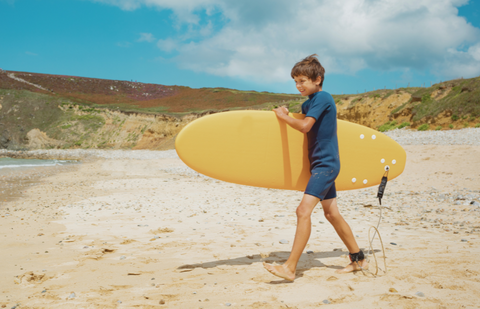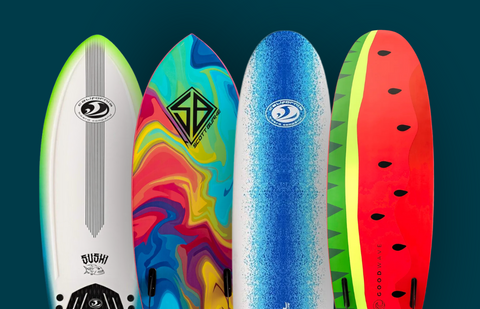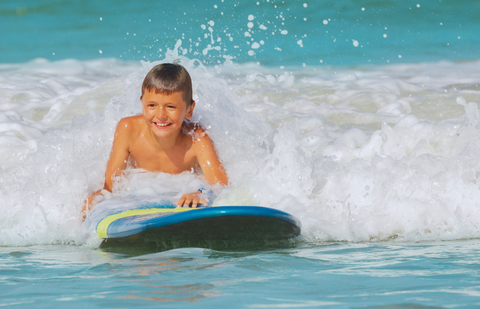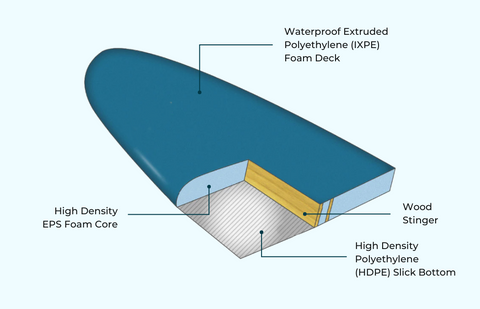Introduction
Selecting the right surfboard is a crucial step in introducing children to the world of surfing, a decision that can significantly impact their initial experiences and development in the sport. The right kids foam surfboard will provide a platform that is not only safe but also conducive to learning and progression. This guide delves into why choosing a kids foam surfboard is so important for young beginners, aiming to equip parents and guardians with the knowledge to make informed decisions that will foster a positive and enjoyable introduction to surfing for their children.

The journey into surfing starts with the very first wave, and the choice of surfboard can either make this experience exhilarating or daunting for a young surfer. Foam surfboards, with their buoyant and forgiving nature, offer an ideal starting point. They are designed to minimize the risks and challenges associated with learning to surf, making them a superior choice for children. As we explore the benefits and considerations of selecting a kids foam surfboard, it becomes apparent that this choice is about ensuring a foundation that supports skill development, confidence building, and, most importantly, safety on the waves.
Essentials of Choosing a Kids Foam Surfboards
Choosing the right surfboard for a child embarking on their surfing journey is paramount to ensuring they have a safe, enjoyable, and successful introduction to the sport. A kids foam surfboard stands out as the ideal starter board for several compelling reasons.

Why Foam Surfboards?
- Safety:
- The soft exterior of foam surfboards reduces the risk of injuries that can occur from falls or impacts, making them a safer option for beginner surfers.
- Compared to hard topped surfboards, foam boards significantly lessen the chance of bruises or cuts.
- Buoyancy:
- The inherent buoyancy of foam surfboards makes them float better on water. This feature is crucial for beginners learning to stand up on the board, as it provides a more stable platform.
- A buoyant board facilitates easier paddling and catching waves, two essential skills for new surfers.
- Ease of Handling:
- Lighter than fiberglass surfboards, foam boards are easier for kids to carry to and from the water, fostering independence and confidence.
- Their ease of maneuverability in the water helps beginner surfers in riding waves and making turns, which can be more challenging with heavier, less forgiving boards.
Foam vs. Fiberglass Surfboards
- Foam Surfboard:
- Best beginner surfboard due to its forgiving nature and ease of use.
- Ideal for complete beginners and those in the early stages of their surfing adventure.
- Fiberglass Surfboard:
- Typically used by intermediate to advanced surfers due to their rigidity and responsiveness.
- Offers higher performance but at the expense of a steeper learning curve and increased risk of injury for beginner boards.
Selecting a kids foam surfboard as the first surfboard is a decision that prioritizes the safety, learning curve, and overall enjoyment for young surfers. The soft top surfboard, with its soft top and foam material, provides a forgiving platform that encourages kids to catch more waves and gain confidence in their abilities without the intimidation or hazards associated with harder boards. As such, a foam board represents not just a piece of equipment, but a gateway to a lifelong passion for surfing, making it an essential choice for any beginner surfer.
Advantages of Foam Surfboards for Young Surfers
Foam surfboards offer additional benefits that make them the preferred choice for young beginners. These boards are designed with features that cater to the unique needs of novice surfers, emphasizing safety, learning efficiency, and overall enjoyment. Below, we explore the key advantages of foam surfboards in detail.

Durability
- Long-lasting Material: Foam surfboards are crafted from robust foam material, which can withstand the inevitable bumps and knocks that come with learning to surf. This durability ensures the surfboard can accompany young surfers throughout their learning curve.
- Low Maintenance: Unlike fiberglass surfboards that may require frequent repairs from dings and cracks, foam boards are more resilient to damage, making them a cost-effective option for parents.
Stability
- Enhanced Floatation: The buoyant nature of foam surfboards provides excellent floatation, a critical factor for beginners who are mastering the basics of standing up and balancing on the board.
- Wider Design: Many foam surfboards feature a wider design, offering a larger surface area that contributes to greater stability in the water. This design aids beginners in catching waves and standing up with more ease.
Forgiving Nature
- Soft Impact: Falls are part of the learning process in surfing. Foam surfboards minimize the risk of injuries with their soft exterior, making the experience less intimidating and more enjoyable for young surfers.
- Easier Wave Catching: The forgiving nature of foam surfboards, combined with their buoyancy and stability, makes it easier for beginners to catch waves. This positive reinforcement encourages continued practice and skill development.
Ideal for Learning
- Rapid Progression: The combination of durability, stability, and a forgiving nature allows young surfers to focus on improving their skills without the fear of injury or damage to the board. As a result, beginners can progress more quickly in their surfing journey.
- Confidence Building: Successfully catching waves and standing up on a surfboard are pivotal moments for young surfers. Foam surfboards make these achievements more attainable, fostering a sense of accomplishment and building confidence in their abilities.
The advantages of foam surfboards underscore why they are the top choice for young beginners. From their durable and low-maintenance design to the stability and forgiving nature that enhance learning, foam surfboards provide a supportive and enjoyable introduction to the world of surfing.
Key Features to Look for in a Beginner Surfboard
When selecting a beginner surfboard, particularly for young or novice surfers, understanding the key features that contribute to an effective and enjoyable learning experience is crucial. These features are designed to enhance buoyancy, stability, and ease of use, all of which are vital for beginners mastering the basics of surfing. Below, we examine the essential features to look for in beginner surfboards and their impact on a beginner's ability to catch waves and maintain balance.

Dual Composite Core
- Enhanced Buoyancy and Strength: A dual composite, often found in high-quality foam surfboards, provides a perfect balance between buoyancy and strength. This core structure supports the surfer's weight effectively while making the board light enough for easy handling, crucial for beginner surfers.
Foam Core
- Safety and Comfort: The foam core is central to the foam surfboard's design, offering a soft surface that reduces the risk of injuries during falls. This feature is especially important for beginners learning to surf, as it provides a more forgiving platform compared to the hard surface of a fiberglass board.
HDPE Slick Bottom
- Smooth Ride and Durability: A High-Density Polyethylene (HDPE) slick bottom is a common feature in soft top surfboards that contributes to a smoother ride on the water. It enhances the board's glide and speed in wave conditions, making it easier for beginners to catch waves. Additionally, the HDPE slick bottom is known for its durability, offering protection against rocks and reefs.
Round Tail
- Versatility in Wave Conditions: The round tail design in surfboards is advantageous for beginner surfers as it provides a balanced blend of stability and maneuverability. This tail shape performs well in a variety of wave conditions, allowing new surfers to experience different surfing environments with a single board.
Soft Top
- Grip and Stability: The soft top of a foam surfboard, coated with a textured surface, offers additional grip for beginner surfers, reducing the likelihood of slipping off the board. This feature, coupled with the board's overall stability, enables beginners to stand and balance more easily, fostering quicker progression in their surfing journey.
The right combination of features in a beginner surfboard can significantly influence a new surfer's ability to learn and enjoy the sport. Features like the foam core, HDPE slick bottom, round tail, and soft top are engineered to support beginner surfers in catching waves and maintaining balance with greater ease. By prioritizing these features when choosing a beginner surfboard, parents and young surfers can ensure a more rewarding and successful introduction to surfing.
Selecting the Right Size and Type of Surfboard for Beginner Surfers
Choosing the appropriate surfboard size and type is critical for beginner surfers to ensure safety, ease of learning, and progression. Here's a concise guide to help make this important decision.

Surfboard Size
- Weight and Height: Select a surfboard that supports the surfer's weight and height. Beginners generally benefit from larger boards for better stability and buoyancy.
- Skill Level: Beginners should start with longer and wider boards to ease wave catching and improve balance. As skills improve, surfers can transition to smaller boards.
Surfboard Type
- Soft Top Surfboards: Ideal for beginners due to their safety and ease of use. They offer a soft, forgiving surface that minimizes injury risk.
- Foam Boards: Synonymous with soft tops, these boards are buoyant, stable, and suitable for beginner surfers. They provide a safe learning platform.
- Hard Topped Surfboards: Best for more experienced surfers. These boards offer higher performance but are less forgiving, requiring more skill to manage.
For beginner surfers, choosing a surfboard that matches their physical size and accommodates their beginner skill level is essential. Starting with a soft top or foam board is recommended for its safety, stability, and ease of learning. As proficiency increases, surfers can consider transitioning to hard topped surfboards for advanced performance.
Transition from Foam to Fiberglass Surfboards
The transition from a foam surfboard to a fiberglass board is a significant milestone in a surfer's journey, marking the progression from beginner to intermediate level. This shift involves considerations of skill improvement, confidence, and the ability to handle varied wave conditions. Here's a structured look at when and why making this transition is appropriate.

Recognizing Readiness
- Skill Improvement: The surfer has mastered the basics on a foam board, such as paddling effectively, catching waves consistently, and maintaining balance while riding.
- Increased Confidence: There's a noticeable boost in confidence, with the surfer feeling ready to tackle more challenging waves and maneuvers.
- Understanding Wave Conditions: The surfer has gained an understanding of different wave types and conditions, and how they affect surfing dynamics.
Factors Influencing the Transition
- Seeking Performance: Fiberglass surfboards offer better performance in terms of speed and maneuverability, appealing to surfers looking to enhance their skills.
- Wave Conditions: As surfers explore a variety of surfing locations, they may find that fiberglass boards better suit certain types of waves, especially larger and more powerful ones.
- Personal Growth: The desire for personal development and to experience the full range of surfing sensations can drive the move to a fiberglass board.
Considerations Before Making the Transition
- Physical Preparedness: Ensure that the physical demands of handling a fiberglass board, which is less buoyant and more rigid, can be met.
- Safety: Recognize that fiberglass boards, being harder and faster, also come with increased risk of injury.
- Investment: Fiberglass surfboards are generally more expensive and require more care and maintenance than foam boards.
Advancing from a foam surfboard to a fiberglass surfboard represents a graduation of sorts in a surfer's development, symbolizing a move from beginner to intermediate surfer. This decision should be based on a solid foundation of skills, confidence, and an understanding of wave conditions. Making this shift at the right time can open up a new dimension in the surfing experience, creating a deeper connection with the sport.
Maintenance and Care for Foam Surfboards
Ensuring the longevity and maintaining the performance of a kids foam surfboard requires diligent care and regular maintenance. Like any cherished piece of equipment, a foam surfboard needs attention to detail in its upkeep to continue providing the best experience for young and beginner surfers. Here, we explore essential tips on storage, cleaning, and conducting minor repairs, which are key practices in extending the life of these beginner-friendly boards.

Storage
- Avoid Direct Sunlight: Prolonged exposure to the sun can damage the foam material, leading to warping and delamination. Store your board in a shaded or indoor area when not in use.
- Use Surfboard Bags: Protect your foam surfboard from scratches and UV damage by using a surfboard bag, especially during transportation.
- Vertical Position: Storing the board vertically helps distribute pressure evenly, preventing deformation.
Cleaning
- Rinse with Fresh Water: After every surfing session, rinse your board with fresh water to remove salt, sand, and other debris, which can degrade the foam over time.
- Mild Soap for Tough Stains: For stubborn stains, use a mild soap and a soft cloth to clean the surface without damaging the foam.
Minor Repairs
- Seal Dings Immediately: Water ingress from dings and cracks can compromise the foam core. Use foam-safe repair kits to seal any damage promptly.
- Avoid DIY on Large Repairs: For extensive damage, it's advisable to seek professional repair services to ensure the board's structural integrity is maintained.
General Care Tips
- Don't Over-tighten Leash Strings: Tightening the leash string too much can create undue pressure on the board, leading to damage.
- Waxing: Apply surf wax regularly to maintain grip. Make sure to use wax that's compatible with foam surfboards.
- Regular Checks: Inspect your board regularly for wear and tear, particularly before and after sessions, to catch and address any issues early.
By adhering to these maintenance and care guidelines, surfers can ensure their boards remain in prime condition, ready for many more sessions of catching waves and building skills on the water.
Conclusion
Selecting the ideal kids foam surfboard is a crucial decision that lays the foundation for a safe, enjoyable, and successful introduction to surfing for young enthusiasts. These boards are designed to facilitate learning and confidence as children take their first steps to ride waves. By prioritizing the appropriate features, size, and care for these surfboards, parents and guardians can ensure a positive and enriching surfing experience from the very start. The transition from navigating the first gentle waves on a foam surfboard to confidently handling more challenging surf embodies the remarkable journey of growth and discovery in the sport of surfing.
Frequently Asked Questions
What size surfboard for an 8-year-old?
For an 8-year-old, the size of the surfboard should primarily depend on the child’s height, weight, and skill level. Generally, a surfboard ranging from 6 to 7 feet in length is suitable for children of this age, providing enough stability for learning while still being manageable for them to handle.
Should I start on a foam surfboard?
Yes, starting on a foam surfboard is highly recommended for beginners of all ages. Foam surfboards offer a safer, more forgiving platform for learning the basics of surfing, such as paddling, standing up, and riding waves. Their buoyancy and stability make catching waves easier for novices.
What is the easiest surfboard to learn on?
The easiest surfboard to learn on is a soft top foam surfboard. Its soft, buoyant, and stable design is ideal for beginners learning to catch waves and stand up. Foam surfboards reduce the risk of injuries and boost confidence as learners master the fundamentals of surfing.
Can a beginner surfer use a fiberglass board?
While it is possible for a beginner surfer to use a fiberglass board, it is not recommended as the best option for starting out. Fiberglass boards are less buoyant and more rigid, making them more challenging for beginners to paddle, catch waves, and balance on. Foam surfboards are generally safer and more forgiving for those new to the sport.
Are foam boards easier?
Yes, foam boards are easier for beginners to use compared to fiberglass or epoxy boards. Their construction offers superior buoyancy and stability, which greatly aids in learning how to paddle, catch waves, and balance. Additionally, the soft material of foam boards minimizes the risk of injuries during falls, making the learning process more enjoyable and less intimidating.



